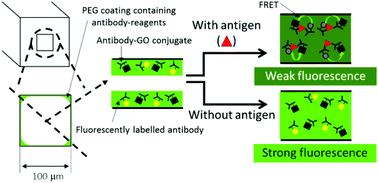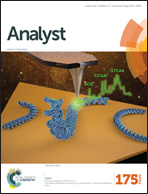Fast and single-step immunoassay based on fluorescence quenching within a square glass capillary immobilizing graphene oxide–antibody conjugate and fluorescently labelled antibody†
Abstract
A single-step, easy-to-use, and fast capillary-type immunoassay device composed of a polyethylene glycol (PEG) coating containing two kinds of antibody-reagents, including an antibody–graphene oxide conjugate and fluorescently labelled antibody, was developed in this study. The working principle involved the spontaneous dissolution of the PEG coating, diffusion of reagents, and subsequent immunoreaction, triggered by the capillary action-mediated introduction of a sample solution. In a sample solution containing the target antigen, two types of antibody reagents form a sandwich-type antigen–antibody complex and fluorescence quenching takes place via fluorescence resonance energy transfer between the labelled fluorescent molecules and graphene oxide. Antigen concentration can be measured based on the decrease in fluorescence intensity. An antigen concentration-dependent response was obtained for the model target protein sample (human IgG, 0.2–10 μg mL−1). The present method can shorten the reaction time to within 1 min (approximately 40 s), while conventional methods using the same reagents require reaction times of approximately 20 min because of the large reaction scale. The proposed method is one of the fastest immunoassays ever reported. Finally, the present device was used to measure human IgG in diluted serum samples to demonstrate that this method can be used for fast medical diagnosis.


 Please wait while we load your content...
Please wait while we load your content...